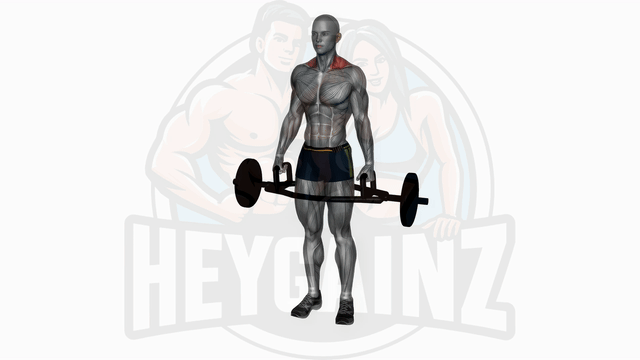
Instructions:
- 1Stand between a trap bar with your back straight ad feet shoulder-width apart.
- 2Hold the handles of the bar while keeping your arms straight by your side.
- 3Raise the bar by lifting your shoulders toward your ears.
- 4Hold for a while, return to the initial position, and repeat.
Tips:
- Keep your back straight and avoid slouching.
- DonÆt bend your elbows or raise your heels off the floor.
- Maintain a regular breathing pattern.
Unlocking the Benefits of Trap Bar Shrugs
The trap bar shrug is a highly effective exercise for developing the upper body, specifically targeting the trapezius muscles. This movement is commonly performed with a trap bar, which allows for a more natural grip and body position compared to traditional barbell shrugs. If you are seeking to enhance your workout routine, incorporating trap bar shrugs can significantly contribute to your strength training results.
Muscles Worked
During trap bar shrugs, the primary muscles engaged include the trapezius, rhomboids, and deltoids. Additionally, it activates secondary muscles such as the biceps and forearms, making it a well-rounded choice for upper body development.
Benefits of Trap Bar Shrugs
- Improved Posture: Building strength in the trapezius and upper back can lead to better posture in daily activities.
- Reduced Risk of Injury: Strengthening the upper back stabilizers can help prevent injuries during other lifts.
- Enhanced Grip Strength: As you hold the weight, you also develop grip strength, beneficial for various exercises.
Trap Bar Shrugs vs. Barbell Shrugs
When comparing trap bar shrugs to traditional barbell shrugs, many find that the trap bar allows for a more comfortable grip and optimal body mechanics. The unique design of the trap bar positions the weight around the body, lowering the risk of strain on the lower back, making it a safer option for many individuals.
Rep Range and Standards
A typical rep range for trap bar shrugs is between 8 to 12 repetitions for 3 to 4 sets, depending on your fitness goals. Emphasize proper form to maximize effectiveness while minimizing injury risk. For those aspiring to lift heavier, following trap bar shrug standards can help you gauge your progress.
Form Tips
To execute an effective trap bar shrug:
- Stand within the trap bar with your feet shoulder-width apart.
- Bend at the hips and knees to grasp the handles, keeping your back straight.
- Stand tall while lifting your shoulders towards your ears, focusing on contracting your trapezius muscles.
- Return to the starting position with control.
Alternatives to Trap Bar Shrugs
If you're looking for trap bar shrug alternatives, consider dumbbell shrugs or kettlebell shrugs as effective substitutes. These variations can still target the trapezius while offering different training stimuli.
Whether you are new to strength training or a seasoned athlete, adding trap bar shrugs to your regimen can enhance your upper body strength and support your overall fitness journey. Engage with this versatile exercise and enjoy the benefits it brings!